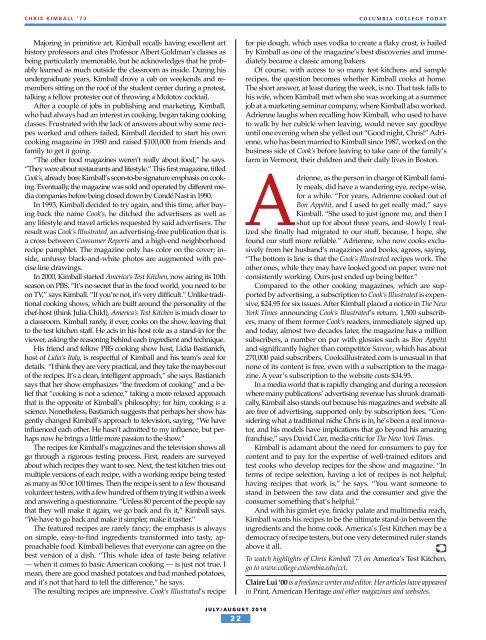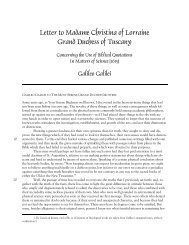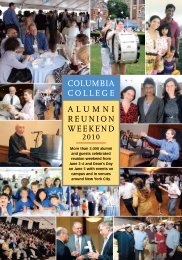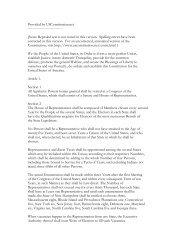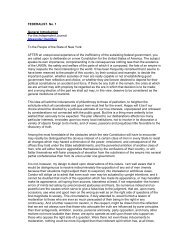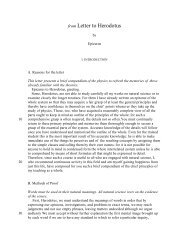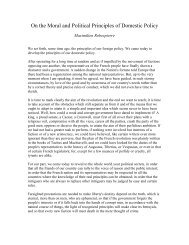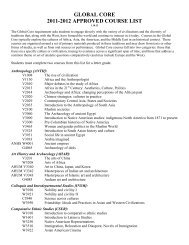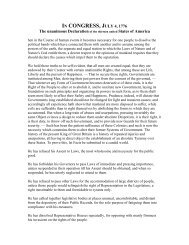Congratulations, Class of 2010! - Columbia College - Columbia ...
Congratulations, Class of 2010! - Columbia College - Columbia ...
Congratulations, Class of 2010! - Columbia College - Columbia ...
You also want an ePaper? Increase the reach of your titles
YUMPU automatically turns print PDFs into web optimized ePapers that Google loves.
chris kimball ’73<br />
columbia college today<br />
Majoring in primitive art, Kimball recalls having excellent art<br />
history pr<strong>of</strong>essors and cites Pr<strong>of</strong>essor Albert Goldman’s classes as<br />
being particularly memorable, but he acknowledges that he probably<br />
learned as much outside the classroom as inside. During his<br />
undergraduate years, Kimball drove a cab on weekends and remembers<br />
sitting on the ro<strong>of</strong> <strong>of</strong> the student center during a protest,<br />
talking a fellow protester out <strong>of</strong> throwing a Molotov cocktail.<br />
After a couple <strong>of</strong> jobs in publishing and marketing, Kimball,<br />
who had always had an interest in cooking, began taking cooking<br />
classes. Frustrated with the lack <strong>of</strong> answers about why some recipes<br />
worked and others failed, Kimball decided to start his own<br />
cooking magazine in 1980 and raised $100,000 from friends and<br />
family to get it going.<br />
“The other food magazines weren’t really about food,” he says.<br />
“They were about restaurants and lifestyle.” This first magazine, titled<br />
Cook’s, already bore Kimball’s soon-to-be signature emphasis on cooking.<br />
Eventually, the magazine was sold and operated by different media<br />
companies before being closed down by Condé Nast in 1990.<br />
In 1993, Kimball decided to try again, and this time, after buying<br />
back the name Cook’s, he ditched the advertisers as well as<br />
any lifestyle and travel articles requested by said advertisers. The<br />
result was Cook’s Illustrated, an advertising-free publication that is<br />
a cross between Consumer Reports and a high-end neighborhood<br />
recipe pamphlet. The magazine only has color on the cover; inside,<br />
unfussy black-and-white photos are augmented with precise<br />
line drawings.<br />
In 2000, Kimball started America’s Test Kitchen, now airing its 10th<br />
season on PBS. “It’s no secret that in the food world, you need to be<br />
on TV,” says Kimball. “If you’re not, it’s very difficult.” Unlike traditional<br />
cooking shows, which are built around the personality <strong>of</strong> the<br />
chef-host (think Julia Child), America’s Test Kitchen is much closer to<br />
a classroom. Kimball rarely, if ever, cooks on the show, leaving that<br />
to the test kitchen staff. He acts in his host role as a stand-in for the<br />
viewer, asking the reasoning behind each ingredient and technique.<br />
His friend and fellow PBS cooking show host, Lidia Bastianich,<br />
host <strong>of</strong> Lidia’s Italy, is respectful <strong>of</strong> Kimball and his team’s zeal for<br />
details. “I think they are very practical, and they take the maybes out<br />
<strong>of</strong> the recipes. It’s a clean, intelligent approach,” she says. Bastianich<br />
says that her show emphasizes “the freedom <strong>of</strong> cooking” and a belief<br />
that “cooking is not a science,” taking a more relaxed approach<br />
that is the opposite <strong>of</strong> Kimball’s philosophy; for him, cooking is a<br />
science. Nonetheless, Bastianich suggests that perhaps her show has<br />
gently changed Kimball’s approach to television, saying, “We have<br />
influenced each other. He hasn’t admitted to my influence, but perhaps<br />
now he brings a little more passion to the show.”<br />
The recipes for Kimball’s magazines and the television shows all<br />
go through a rigorous testing process. First, readers are surveyed<br />
about which recipes they want to see. Next, the test kitchen tries out<br />
multiple versions <strong>of</strong> each recipe, with a working recipe being tested<br />
as many as 50 or 100 times. Then the recipe is sent to a few thousand<br />
volunteer testers, with a few hundred <strong>of</strong> them trying it within a week<br />
and answering a questionnaire. “Unless 80 percent <strong>of</strong> the people say<br />
that they will make it again, we go back and fix it,” Kimball says.<br />
“We have to go back and make it simpler, make it tastier.”<br />
The featured recipes are rarely fancy; the emphasis is always<br />
on simple, easy-to-find ingredients transformed into tasty, approachable<br />
food. Kimball believes that everyone can agree on the<br />
best version <strong>of</strong> a dish. “This whole idea <strong>of</strong> taste being relative<br />
— when it comes to basic American cooking — is just not true. I<br />
mean, there are good mashed potatoes and bad mashed potatoes,<br />
and it’s not that hard to tell the difference,” he says.<br />
The resulting recipes are impressive. Cook’s Illustrated’s recipe<br />
for pie dough, which uses vodka to create a flaky crust, is hailed<br />
by Kimball as one <strong>of</strong> the magazine’s best discoveries and immediately<br />
became a classic among bakers.<br />
Of course, with access to so many test kitchens and sample<br />
recipes, the question becomes whether Kimball cooks at home.<br />
The short answer, at least during the week, is no. That task falls to<br />
his wife, whom Kimball met when she was working at a summer<br />
job at a marketing seminar company, where Kimball also worked.<br />
Adrienne laughs when recalling how Kimball, who used to have<br />
to walk by her cubicle when leaving, would never say goodbye<br />
until one evening when she yelled out “Good night, Chris!” Adrienne,<br />
who has been married to Kimball since 1987, worked on the<br />
business side <strong>of</strong> Cook’s before leaving to take care <strong>of</strong> the family’s<br />
farm in Vermont, their children and their daily lives in Boston.<br />
Adrienne, as the person in charge <strong>of</strong> Kimball family<br />
meals, did have a wandering eye, recipe-wise,<br />
for a while. “For years, Adrienne cooked out <strong>of</strong><br />
Bon Appétit, and I used to get really mad,” says<br />
Kimball. “She used to just ignore me, and then I<br />
shut up for about three years, and slowly I realized<br />
she finally had migrated to our stuff, because, I hope, she<br />
found our stuff more reliable.” Adrienne, who now cooks exclusively<br />
from her husband’s magazines and books, agrees, saying,<br />
“The bottom is line is that the Cook’s Illustrated recipes work. The<br />
other ones, while they may have looked good on paper, were not<br />
consistently working. Ours just ended up being better.”<br />
Compared to the other cooking magazines, which are supported<br />
by advertising, a subscription to Cook’s Illustrated is expensive,<br />
$24.95 for six issues. After Kimball placed a notice in The New<br />
York Times announcing Cook’s Illustrated’s return, 1,500 subscribers,<br />
many <strong>of</strong> them former Cook’s readers, immediately signed up,<br />
and today, almost two decades later, the magazine has a million<br />
subscribers, a number on par with glossies such as Bon Appétit<br />
and significantly higher than competitor Saveur, which has about<br />
270,000 paid subscribers. Cooksillustrated.com is unusual in that<br />
none <strong>of</strong> its content is free, even with a subscription to the magazine.<br />
A year’s subscription to the website costs $34.95.<br />
In a media world that is rapidly changing and during a recession<br />
where many publications’ advertising revenue has shrunk dramatically,<br />
Kimball also stands out because his magazines and website all<br />
are free <strong>of</strong> advertising, supported only by subscription fees. “Considering<br />
what a traditional niche Chris is in, he’s been a real innovator,<br />
and his models have implications that go beyond his amazing<br />
franchise,” says David Carr, media critic for The New York Times.<br />
Kimball is adamant about the need for consumers to pay for<br />
content and to pay for the expertise <strong>of</strong> well-trained editors and<br />
test cooks who develop recipes for the show and magazine. “In<br />
terms <strong>of</strong> recipe selection, having a lot <strong>of</strong> recipes is not helpful;<br />
having recipes that work is,” he says. “You want someone to<br />
stand in between the raw data and the consumer and give the<br />
consumer something that’s helpful.”<br />
And with his gimlet eye, finicky palate and multimedia reach,<br />
Kimball wants his recipes to be the ultimate stand-in between the<br />
ingredients and the home cook. America’s Test Kitchen may be a<br />
democracy <strong>of</strong> recipe testers, but one very determined ruler stands<br />
above it all.<br />
To watch highlights <strong>of</strong> Chris Kimball ’73 on America’s Test Kitchen,<br />
go to www.college.columbia.edu/cct.<br />
Claire Lui ’00 is a freelance writer and editor. Her articles have appeared<br />
in Print, American Heritage and other magazines and websites.<br />
july/august <strong>2010</strong><br />
22


